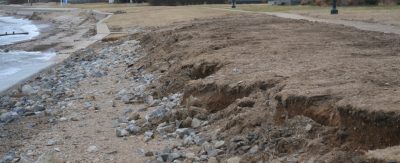Is Your Beach Eroding?
You may have a moderately to highly eroding beach and frequent or recurring problems if:
- Your beach or dunes are continually losing sediment. Look for signs of continued decreasing dune height with no recovery after storm season, continued reduction of beach elevation in front of seawalls, and evidence of sand loss in front of seawalls.
- You see exposed tree roots or peat deposits on the beach which are signs that the surf zone has moved landward to the backside of the beach. Note that presence of these features may only occur after large storms.
- You experience frequent overwash and flooding (i.e., several times each winter) in response to small storm events.
- You experience chronic damage to a shore protection structure such as a seawall or bulkhead. Chronic damage may indicate that the beach is attempting to migrate landward.
- You are located in certain FEMA flood zones such as VE zones, where breaking waves and coastal flooding occur across the extent of the beach.
- You have a home adjacent to an inlet that migrates on a regular basis. Proximity to a tidal inlet that migrates can increase the erosion hazard of the beach and dune.
You may have a generally stable or slightly erosional beach with minor flooding problems if:
- Your beach or dune is stable or growing seaward.
- Your beach or dune is eroding slightly.
- You have dry beach at high tide and stable, vegetated dunes.
- You experience isolated overwash and flooding, only after large storms.
- You are not located in a mapped at-risk flood zone.
If you are not located within a flood hazard zone, you likely don’t have flood insurance because your overall risk of coastal flooding is low, although isolated flooding problems may still occur.
Flood risk changes over time, and as a result FEMA is updating flood hazard maps across the country. Check the National Flood Insurance Program (NFIP) website for updated information.
See the BEACH, DUNE AND COASTAL FLOODING CHECKLIST to help you conduct a field inventory of your property and identify and rank beach and dune hazards.


Eroding beach in Old Saybrook. Photos: Jennifer O’Donnell
My beach is eroding. What can I do?
There are a number of options that property owners can consider to mitigate erosion of their shoreline. The first step is to contact town officials, state agency staff, and coastal experts early and often to explore and understand your options. The Connecticut Department of Energy and Environmental Protection Office of Long Island Sound Programs website Living on the Shore contains information on coastal property owners’ Rights and Opportunities, Coastal Permitting, Residential Dock Guidelines and a fact sheet on the Public Trust.
Actions on beaches and dunes could impact threatened or endangered species such as piping plovers. In these cases, consultation with state and federal wildlife agencies will be needed before action can be taken.
Weigh the risks and the costs with assistance from a coastal engineer, certified geologist, or other coastal expert.
Actions to Consider

This shoreline in Old Saybrook has dry beach above mean high water (MHW) and is backed by an established, vegetated sand dune, indicative of a stable beach. Photo: Jennifer O’Donnell.